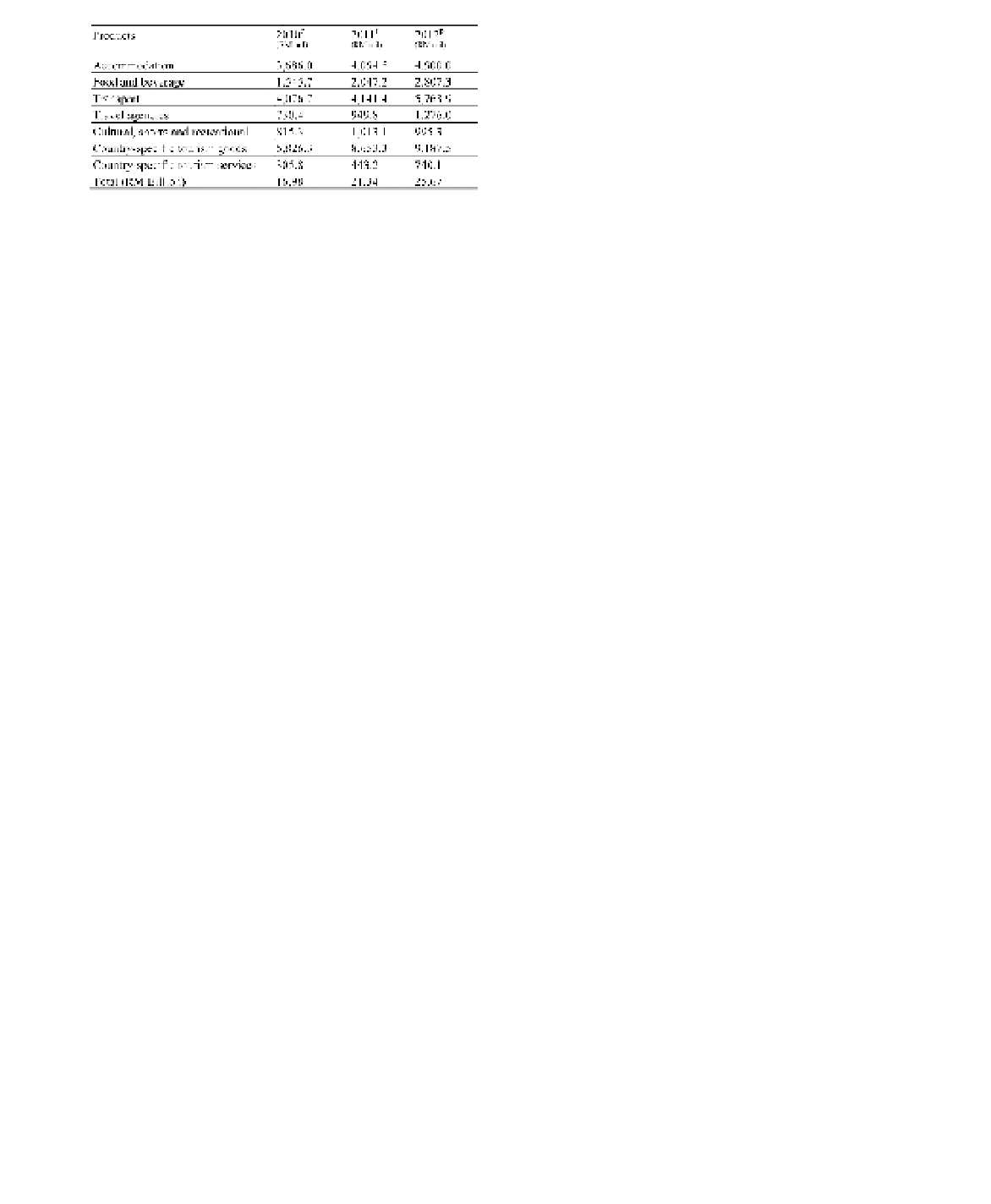Travel Reference
In-Depth Information
Table 1.
Outbound tourism expenditure by products.
one unique resource and focus on a specific market
segment.
Hanqin and Lam (1999) identified several
dimensions of the travel motivations such as repu-
tation, novelty, and service attitude/quality. Chi-
nese repeat tourists perceived that there would be
nothing new for them to explore on their returns,
this is consistent with the study of Beerli and Mar-
tín (2004). However, the study of Li, Cheng, Kim,
and Petrick (2008) stated that repeat tourists had
higher satisfaction levels than first-time tourists.
Consequently, Rittichainuwat, Qu and Mongkhon-
vanit (2008) found significant differences in travel
motivations between first-time and repeat tourists
to Thailand. Further, Liu (2006) argued that des-
tinations possess different stocks of resources that
offer a different appeal to people, such that a tour-
ist will likely travel with different motivation on
different occasions. This theory, therefore, fails to
capture the diverse and changing motives for travel
to different destinations by individuals or groups
of people.
A literature review about motivation reveals that
people travel because they are pushed into making
travel decisions by internal psychological forces
and pulled by the external forces of the destina-
tion attributes (Uysal & Hagan, 1993). The push-
pull framework provides a practical technique for
examining the motivations underlying tourist and
visitation behavior. In this framework, push fac-
tors refer to the specific forces that affect a per-
son's decision to take a trip (i.e., to travel outside
of one's everyday environment), while pull factors
refer to the forces that affect the individual's choice
of which specific destination should be selected.
Additionally, Beerli and Martín (2004) found
that motivations had influenced the affective com-
ponents of the image (pleasant/unpleasant, excit-
ing/boring); for example, first-time tourists who
identified relaxation as the motivation found the
sun and beach destination as attractive, whereas
the repeat tourists went there to increase knowl-
edge of the destination. The study identified that
the more experiences with the destination the
tourists had, the preferable destination image they
would have because they were more familiar with
the destinations.
Mansfeld (1992) suggested that an analysis of the
motivational stage can show the way in which peo-
ple set goals for their destination choice and how
these goals are then reflected in both their choice
and travel behavior. Additionally, this may provide
tour operators, tourism planners, and other tour-
ist-related institutions with a better understanding
of the real expectations, needs and goals of tour-
ists. Such an understanding is necessary to create
travel products designed to meet these needs and
expectations.
Source: Tourism Satellite Account (2012).
tourism characteristic goods (shopping) followed
by passenger transport services and accommoda-
tion services.
In basic economic, outbound tourism is viewed
as an import. It is considered as leakage in the
national economy and affect negatively on the
national account (Smeral & Witt, 1996). Abundant
studies have been conducted to assess the factors
that drive people to travel (Bieger & Laesser, 2002;
Kozak, 2002; Prebensen, 2006; Winter, 2009).
However, studies on outbound tourism motives
are scarce. Thus, this paper explores the determi-
nants for outbound tourism with the intention to
construct a structural model on travel motivation
dimension.
2 LITERATURE
2.1
Tourism motivation
Motivation theory can be classified into two forces
suggesting that people travel because they are
pushed and pulled to do so by ''some forces'' or fac-
tors (Dann, 1981). According to Uysal and Hagan
(1993), these forces describe how individuals are
pushed by motivation variables into making travel
decisions and how they are pulled or attracted by
destination attributes. Push motivations are akin
to psychological or emotional aspects. Contrarily,
pull motivations connect to external, situational,
or cognitive aspects (Yoon & Uysal, 2005, Hana-
fiah, et al., 2010). Furthermore, Josiam, Kinley
and Kim (2005) analyses the concept of 'push'
and 'pull' motivation. 'Push' motivations are the
socio-psychological needs that motivate a person
to travel.
Based from Kim and Lee (2002), the influ-
ence of attractions in a destination area consid-
ered as exerting a pull response on the individual.
Resources considered pulling factors include nat-
ural attractions, cultural resources, recreational
activities, special events or festivals, and other
entertainment opportunities. Some destinations
feature an assortment of these various resources
to meet a variety of motives while others represent




Search WWH ::

Custom Search